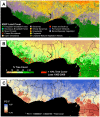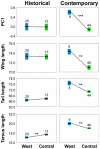Human impacts flatten rainforest-savanna gradient and reduce adaptive diversity in a rainforest bird
- PMID: 20941360
- PMCID: PMC2948002
- DOI: 10.1371/journal.pone.0013088
Human impacts flatten rainforest-savanna gradient and reduce adaptive diversity in a rainforest bird
Erratum in
- PLoS One. 2010;5(10). doi: 10.1371/annotation/d50ccb46-fd60-450d-8c2c-4c3be512deac
Abstract
Ecological gradients have long been recognized as important regions for diversification and speciation. However, little attention has been paid to the evolutionary consequences or conservation implications of human activities that fundamentally change the environmental features of such gradients. Here we show that recent deforestation in West Africa has homogenized the rainforest-savanna gradient, causing a loss of adaptive phenotypic diversity in a common rainforest bird, the little greenbul (Andropadus virens). Previously, this species was shown to exhibit morphological and song divergence along this gradient in Central Africa. Using satellite-based estimates of forest cover, recent morphological data, and historical data from museum specimens collected prior to widespread deforestation, we show that the gradient has become shallower in West Africa and that A. virens populations there have lost morphological variation in traits important to fitness. In contrast, we find no loss of morphological variation in Central Africa where there has been less deforestation and gradients have remained more intact. While rainforest deforestation is a leading cause of species extinction, the potential of deforestation to flatten gradients and inhibit rainforest diversification has not been previously recognized. More deforestation will likely lead to further flattening of the gradient and loss of diversity, and may limit the ability of species to persist under future environmental conditions.
Conflict of interest statement
Figures




Similar articles
-
Evolutionary consequences of human disturbance in a rainforest bird species from Central Africa.Mol Ecol. 2008 Jan;17(1):58-71. doi: 10.1111/j.1365-294X.2007.03478.x. Epub 2007 Sep 12. Mol Ecol. 2008. PMID: 17868295
-
Genomic divergence across ecological gradients in the Central African rainforest songbird (Andropadus virens).Mol Ecol. 2017 Oct;26(19):4966-4977. doi: 10.1111/mec.14270. Epub 2017 Aug 21. Mol Ecol. 2017. PMID: 28752944
-
Evidence for ecotone speciation across an African rainforest-savanna gradient.Mol Ecol. 2023 May;32(9):2287-2300. doi: 10.1111/mec.16867. Epub 2023 Feb 12. Mol Ecol. 2023. PMID: 36718952
-
The ongoing cut-down of the Amazon rainforest threatens the climate and requires global tree planting projects: A short review.Environ Res. 2020 Feb;181:108887. doi: 10.1016/j.envres.2019.108887. Epub 2019 Nov 1. Environ Res. 2020. PMID: 31732170 Review.
-
Tropical forests and the changing earth system.Philos Trans R Soc Lond B Biol Sci. 2006 Jan 29;361(1465):195-210. doi: 10.1098/rstb.2005.1711. Philos Trans R Soc Lond B Biol Sci. 2006. PMID: 16553317 Free PMC article. Review.
Cited by
-
Host and habitat specialization of avian malaria in Africa.Mol Ecol. 2012 Jan;21(2):431-41. doi: 10.1111/j.1365-294X.2011.05341.x. Epub 2011 Dec 5. Mol Ecol. 2012. PMID: 22142265 Free PMC article.
-
Planning for the Maintenance of Floristic Diversity in the Face of Land Cover and Climate Change.Environ Manage. 2017 May;59(5):792-806. doi: 10.1007/s00267-017-0829-0. Epub 2017 Feb 4. Environ Manage. 2017. PMID: 28160031
-
Fluctuating asymmetry and environmental stress: understanding the role of trait history.PLoS One. 2013;8(3):e57966. doi: 10.1371/journal.pone.0057966. Epub 2013 Mar 5. PLoS One. 2013. PMID: 23472123 Free PMC article.
References
-
- Smith TB, Wayne RK, Girman DJ, Bruford MW. A role for ecotones in generating rainforest biodiversity. Science. 1997;276:1855–1857.
-
- Slabbekoorn H, Smith TB. Habitat-dependent song divergence in the little greenbul: an analysis of environmental selection pressures on acoustic signals. Evolution. 2002;56:1849–1858. - PubMed
-
- Seehausen O, Terai Y, Magalhaes IS, Carleton KL, Mrosso HDJ, et al. Speciation through sensory drive in cichlid fish. Nature. 2008;455:620–626. - PubMed
Publication types
MeSH terms
LinkOut - more resources
Full Text Sources
Other Literature Sources

